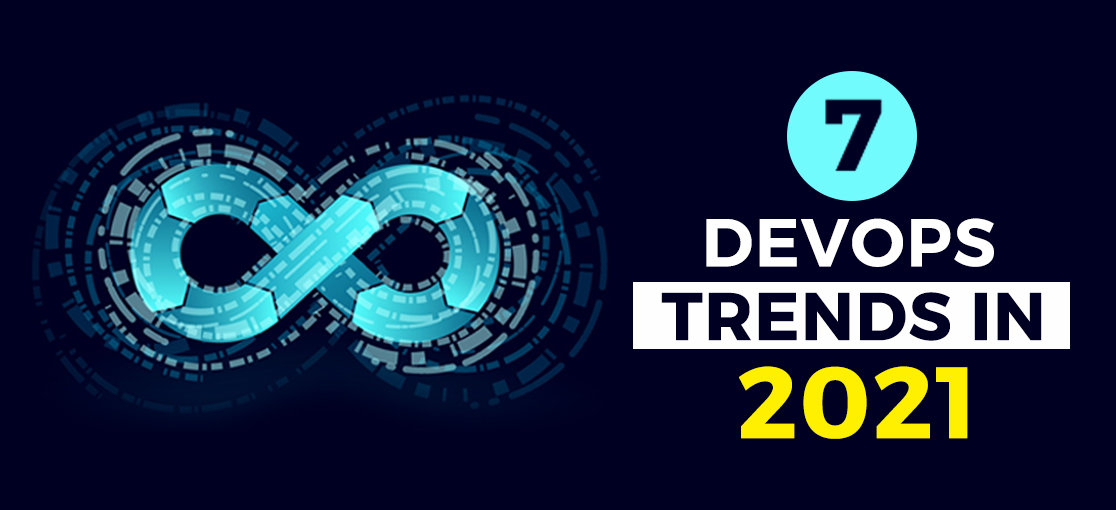- Web App Development
Keeping an Eye On 7 DevOps Trends in 2021
Posted on 21-07-2021
Posted by devmin

DevOps has evolved as a widespread practice in the software industry rapidly acquired by software developers and companies. DevOps is a combination of software development and IT operations to deliver the most efficient software model. The efficiency of this model has made it a dominating approach in the industry. Not only this, this approach is continuously evolving and improving with time. The DevOps community and engineers keep looking for ways to improve development practices and increase productivity. That suggests that we can expect new trends in DevOps development in the future. We can see some of the leading trends happening in 2021. Before we move on to explore those, let’s first understand DevOps briefly to get a better grasp on trends and evolution in this domain. Here you go!
What is DevOps?
DevOps is a set of development and operations processes combining in the entire service lifecycle. From design through the development process to production support.
DevOps shows strong associations and similarities with agile and lean approaches. It deals with the two components separately, Dev and Ops. In contrast, the Ops or operations side refers to those operating or dealing with the product after its development. Handling these two areas can make the process unreal or challenging. That is why the DevOps approach came into being at the core of its operations—having practicality and ease-of-use the core agendas of DevOps. This approach interprets an outgrowth of the agile software development approach. Agile also includes a close collaboration of developers, customers, product management, and QA to overcome the glitches by iteration to make a better product. DevOps caters to service delivery and systems interaction with the users, as these are a fundamental part of this approach. Put it, DevOps is extending agile principles beyond the code and development boundaries to the delivery and operation services.
Now let’s begin with the leading DevOps trends, which you should keep an eye on in the years ahead.
1. The Rise in Template-Based Practices
DevOps approach requires teams to self-organize and regulate their processes to specific development needs. DevOps teams will work on evolving standardized methods and frameworks into customized and convenient working forms.
By 2023, most companies will adjust agile practices to match the product and team contexts. As a result, the application delivery pace will improve. That will also bring a rise in emerging techniques that emphasize evolving practices over conventional methods. Essence and Disciplined Agile is a demonstration of this.
2. The Rise of AI and Machine Learning in DevOps
As the use of AI and ML is continuously increasing in all sectors and industries. It comes as no surprise that the DevOps approach will also see an increase in AI and ML integration into DevOps processes. The two leading technologies will help DevOps optimize and automate operational feedback, root cause analysis, and big data processing. All of this eventually leads to finding new ways of solving problems and reaching higher levels of efficiency. DevOps tools would be used to monitor the infrastructure and monitor the business and drive value-focused initiatives through predictive DevOps.
3. Application Performance Monitoring (APM) Software
APM potentially plays a crucial role in providing quick feedback to developers during deployments. APM software covers front-end monitoring, application discovery, tracing, diagnostics (ADTD), and AIOps. Where front-end monitoring evaluates the performance and behavior of UI, ADTD analyzes the relations between web and application servers, micro services, and infrastructures, and AIOps powered analytics detects patterns, anomalies, and causality across the development life cycle).
APM is integral to shortening MTTR, the Mean Time to Repair, maintaining service availability, and refining user experience. Advanced APM capabilities will help DevOps teams better understand business processes, help with problem identification and prioritization, and deliver insights into business operations.
APM vendors will further expand their offerings in the upcoming years to include integrated infrastructure monitoring and analysis. Machine language in APM reduces system noise, predicts and detects anomalies, and identifies causality.
The increasing demands of enhanced customer experience will drive APM software to offer understandings into the user experience. In short, software development companies will rely more on APM software to understand and improve their applications.
4. The Rise of Security – DevSecOps
Cloud-native security will be on the rise as organizations move on to serverless cloud-based technologies. The development and operations team need new ways to protect assets, and this drives a wide adoption of DevSecOps in 2021 and years ahead.
DevSecOps refers to the integration of security and compliance testing into development channels to seamlessly integrate into the life cycle, provide transparent results to relevant stakeholders, and enhance developers’ agility. Moreover, it eliminates the need to leave specific development environments. All in all, it provides security at runtime.
5. Cloud Management Platforms (CMPs)
Cloud management platforms (CMPs) facilitate organizations to manage public, private, and multi-cloud resources and services. A single product or a set of vendor services can result in CMP functionalities. In the upcoming years, we expect CMP to assist organizations in reducing operational costs and ensure satisfactory service levels.
CMPs will offer many functionalities to businesses, including provisioning and orchestration, service request management, inventory management and classification, cloud monitoring and analytics, and resource optimization. Further, it can help in cloud migration, backup, and disaster recovery.
6. Application Release Orchestration (ARO) Tools
ARO tools offer support to combine pipeline and environment management with release orchestration. The use of ARO tools offers more agility, enhanced productivity, and greater visibility. That helps the team delivers new applications, make changes, and fix bugs more quickly. ARO tools will help reduce manual tasks and allow the staff to focus on more valuable lessons. They will be used more commonly to execute faster delivery of new code in the upcoming areas, enabling organizations to respond to evolving market needs with agility.
7. Enlargement of AgileOps
AgileOps is a set of agile and DevOps practices to improve agility in infrastructure and operations. The evolving demand and need to cater to user requirements will drive the expansion of AgileOps. Organizations will use Agile, Lean, and DevOps methods to be better able to improve the customer journey.
Connect with Invictus Star to learn more about the latest technology and its implementation in your upcoming software projects.



